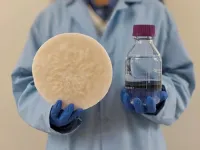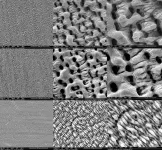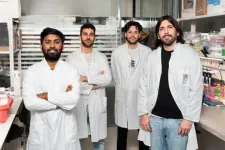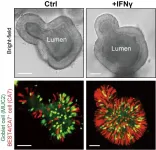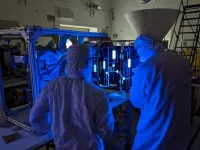From scraps to sips: Everyday biomass produces drinking water from thin air
2025-02-25
(Press-News.org)
Discarded food scraps, stray branches, seashells and many other natural materials are key ingredients in a new system that can pull drinkable water out of thin air developed by researchers from The University of Texas at Austin.
This new “molecularly functionalized biomass hydrogels” system can convert a wide range of natural products into sorbents, materials that absorb liquids. By combining these sorbents with mild heat, the researchers can harvest gallons of drinkable water out of the atmosphere, even in dry conditions.
“With this breakthrough, we’ve created a universal molecular engineering strategy that allows diverse natural materials to be transformed into high-efficiency sorbents,” said Guihua Yu, a professor of materials science and mechanical engineering and Texas Materials Institute at UT Austin. “This opens up an entirely new way to think about sustainable water collection, marking a big step towards practical water harvesting systems for households and small community scale.”
In field tests, the researchers generated 14.19 liters (3.75 gallons) of clean water per kilogram of sorbent daily. Most sorbents can generate between 1 and 5 liters per kilogram per day.
The new research was published in Advanced Materials.
This system represents a new way of designing sorbents, the researchers say. Instead of the traditional "select-and-combine" approach, which requires picking specific materials for specific functions, this general molecular strategy makes it possible to turn almost any biomass into an efficient water harvester.
Unlike existing synthetic sorbents, which use petrochemicals and generally require high energy inputs, the UT Austin team’s biomass-based hydrogel is biodegradable, scalable, and requires minimal energy to release water. The secret lies in a two-step molecular engineering process that imparts hygroscopic properties and thermoresponsive behavior to any biomass-based polysaccharide, such as cellulose, starch, or chitosan.
“At the end of the day, clean water access should be simple, sustainable, and scalable,” said Weixin Guan, a senior doctoral student and the study's lead researcher. “This material gives us a way to tap into nature’s most abundant resources and make water from air—anytime, anywhere.”
The latest innovation is part of Yu’s years-long quest to develop solutions for people lacking access to clean drinking water. He’s developed water-generating hydrogels throughout his career, adapting them for the driest conditions. He recently created an injectable water filtration system, and he has applied his hydrogel technology to farming.
The research team is now working on scaling production and designing real-world device systems for commercialization, including portable water harvesters, self-sustaining irrigation systems, and emergency drinking water devices. Since the beginning, the researchers have focused on scalability and the ability to translate this research into solutions that can help people around the world.
“The biggest challenge in sustainable water harvesting is developing a solution that scales up efficiently and remains practical outside the lab,” said Yaxuan Zhao, a graduate researcher in Yu’s lab. “Since this hydrogel can be fabricated from widely available biomass and operates with minimal energy input, it has strong potential for large-scale production and deployment in off-grid communities, emergency relief efforts, and decentralized water systems.”
END
ELSE PRESS RELEASES FROM THIS DATE:
2025-02-25
COLUMBUS, Ohio – Researchers have developed a battery that can convert nuclear energy into electricity via light emission, a new study suggests.
Nuclear power plants, which generate about 20% of all electricity produced in the United States, produce almost no greenhouse gas emissions. However, these systems do create radioactive waste, which can be dangerous to human health and the environment. Safely disposing of this waste can be challenging.
Using a combination of scintillator crystals, high-density materials that emit light when they absorb radiation, and solar cells, the team, led by researchers from The Ohio State University, demonstrated that ambient ...
2025-02-25
A novel tool for rapidly identifying the genetic “fingerprints” of cancer cells may enable future surgeons to more accurately remove brain tumors while a patient is in the operating room, new research reveals. Many cancer types can be identified by certain mutations, changes in the instructions encoded in the DNA of the abnormal cells.
Led by a research team from NYU Langone Health, the new study describes the development of Ultra-Rapid droplet digital PCR, or UR-ddPCR, which the team found can measure the level of tumor cells in a tissue sample ...
2025-02-25
WASHINGTON, Feb. 25, 2025 – Keeping work surfaces clean during meat processing is a challenge. Bacteria from meat can attach, grow, and build up to create a biofilm that is difficult to remove, even on stainless steel surfaces used in industrial facilities. It can also aggregate, clumping together into an invisible mass that is stronger than individual cells, making it harder to kill using food-grade antibacterial surface cleaners.
In a paper published this week in Journal of Laser Applications, from AIP Publishing and the Laser Institute of America, researchers from the Hopkirk Research Institute, New Zealand Food Safety Science and Research Centre, ...
2025-02-25
About The Study: The findings of this study indicate that higher adherence to the Mediterranean diet is associated with a modest reduction in the risk of obesity-related cancers, independent of adiposity measures. Further research is needed to clarify the mechanisms by which the Mediterranean diet may contribute to cancer prevention.
Corresponding Author: To contact the corresponding author, Inmaculada Aguilera-Buenosvinos, PhD, email iaguilerabuenosvinos@gmail.com.
To access the embargoed study: Visit our For The Media website at this link https://media.jamanetwork.com/
(doi:10.1001/jamanetworkopen.2024.61031)
Editor’s Note: Please see the ...
2025-02-25
Barcelona, 25 February 2025 - Myeloid leukaemias are among the most aggressive blood cancers and have low survival rates. Today, leukaemia patients undergo genetic analysis to identify mutations and select the most appropriate treatment. However, even among patients with the same mutation, disease progression and response to therapy can vary significantly.
A study led by ICREA researcher Dr. Alejo Rodríguez-Fraticelli at IRB Barcelona, and funded by Fundación CRIS contra el cáncer, has now revealed these differences can be explained by the fact that not all blood stem cells ...
2025-02-25
Researchers from the Organoid group at the Hubrecht Institute have found that specific gut cells, BEST4/CA7+ cells, regulate electrolyte and water balance in response to bacterial toxins that cause diarrhea. Their findings, published in Cell Stem Cell, show that these cells greatly increase in number when exposed to the cytokine interferon-γ (IFNγ), presenting a promising target for therapeutic strategies.
In the gut, a variety of cell types collaborate to keep a balance of electrolyte and water. Bacterial infections can disrupt this balance, leading ...
2025-02-25
Working toward more effective tuberculosis (TB) vaccines, researchers at Weill Cornell Medicine have developed two strains of mycobacteria with "kill switches" that can be triggered to stop the bacteria after they activate an immune response. Two preclinical studies, published, Jan. 10 in Nature Microbiology, tackle the challenge of engineering bacteria that are safe for use in controlled human infection trials or as better vaccines. While TB is under control in most developed countries, the disease still kills over a million people a year worldwide.
Spreading easily through ...
2025-02-25
SAN ANTONIO — February 25, 2025 —Four small suitcase-sized spacecraft, designed and built by Southwest Research Institute headquartered in San Antonio, are poised to launch from Vandenberg Space Force Base in California no earlier than Feb. 28. NASA’s Polarimeter to Unify the Corona and Heliosphere, or PUNCH, spacecraft is sharing a ride to space with the Spectro-Photometer for the History of the Universe, Epoch of Reionization and Ices Explorer (SPHEREx) observatory.
“The PUNCH mission will study the solar corona, the Sun’s outer atmosphere, and the solar wind that fills ...
2025-02-25
Knee osteoarthritis (KOA) is prevalent among middle-aged and elderly populations, can cause disability and significantly impairs quality of life. Total knee arthroplasty (TKA) is an effective treatment for end-stage KOA; however, long-term outcome and prosthesis survivorship were limited reported, particularly in Chinese cohorts.
Led by Professor Weng Xi-sheng and Professor Feng Bin, the orthopedic team at Peking Union Medical College Hospital conducted a landmark follow-up study spanning over two decades. The research analyzed KOA patients who underwent primary ...
2025-02-25
OAK BROOK, Ill. – An advanced type of MRI uncovers significant lung abnormalities in children and adolescents with long COVID, according to a new study published today in Radiology, a journal of the Radiological Society of North America (RSNA).
Post-COVID-19 condition, commonly known as long COVID, can affect individuals of all ages and is diagnosed when symptoms persist for more than 12 weeks after an initial COVID-19 infection. Children and adolescents typically experience a milder form of the condition, but common symptoms such as chronic fatigue, headaches and poor concentration can negatively impact school performance and social activities.
While ...
LAST 30 PRESS RELEASES:
[Press-News.org] From scraps to sips: Everyday biomass produces drinking water from thin air
